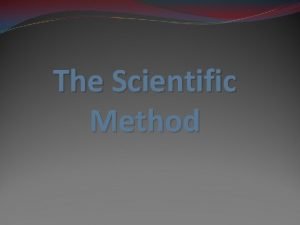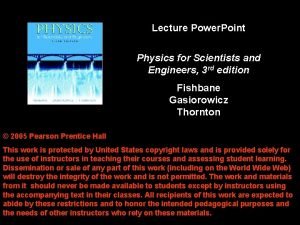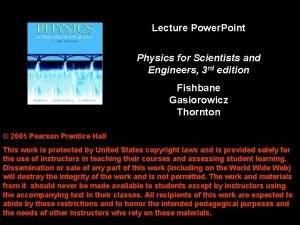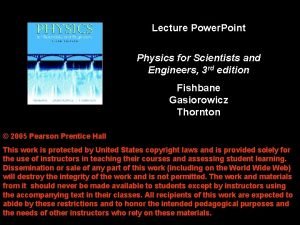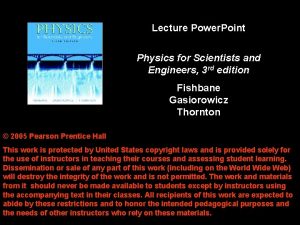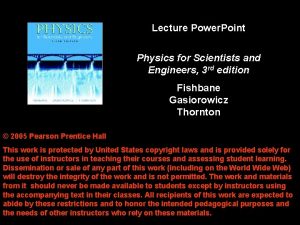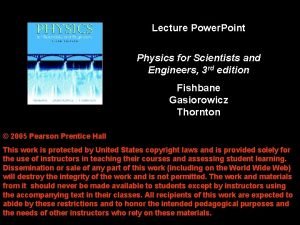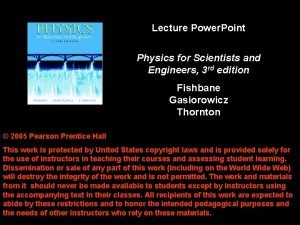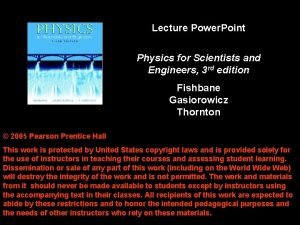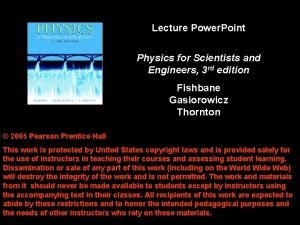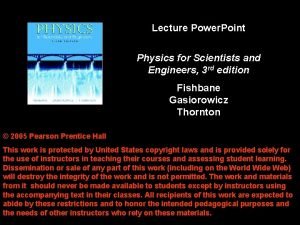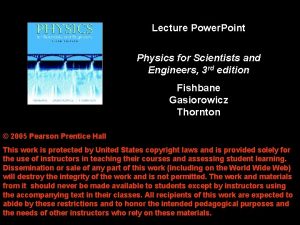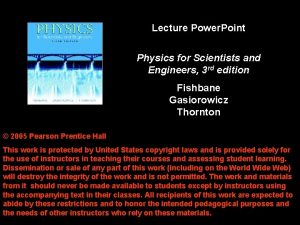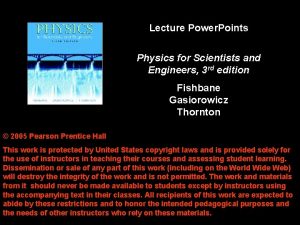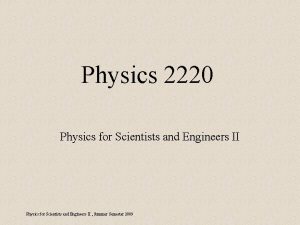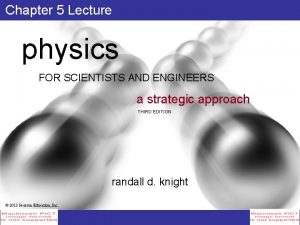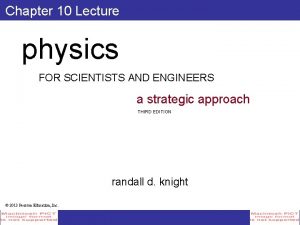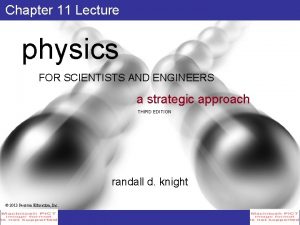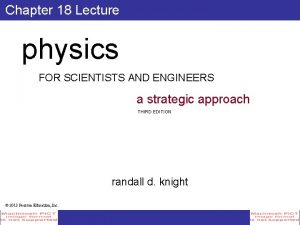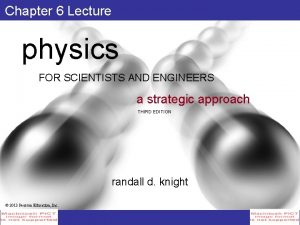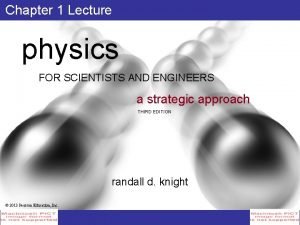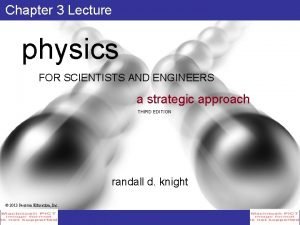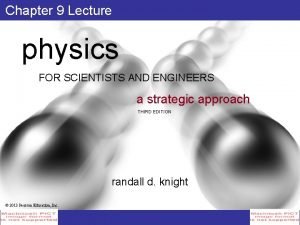Lecture Power Point Physics for Scientists and Engineers



































- Slides: 35

Lecture Power. Point Physics for Scientists and Engineers, 3 rd edition Fishbane Gasiorowicz Thornton © 2005 Pearson Prentice Hall This work is protected by United States copyright laws and is provided solely for the use of instructors in teaching their courses and assessing student learning. Dissemination or sale of any part of this work (including on the World Wide Web) will destroy the integrity of the work and is not permitted. The work and materials from it should never be made available to students except by instructors using the accompanying text in their classes. All recipients of this work are expected to abide by these restrictions and to honor the intended pedagogical purposes and the needs of other instructors who rely on these materials.

Chapter 1 Tooling Up

Main Points of Chapter 1 • Scientific method • Scales from the very small to the very large • Fundamental quantities, units, and unit conversions • Scientific notation • Accuracy and significant figures • Dimensional analysis • Estimating • Scalars and vectors

1 -1 A Little Background Scientific method: interplay between observation and theory. Observations can suggest new theories, which lead to further observations, and so on.

1 -1 A Little Background Newton’s laws describe motions of everyday objects extremely well. Modifications are needed in the realm of the very small – quantum mechanics – and the very large, where we need general relativity. Below we have an image showing single atoms and a supernova remnant.

1 -2 Fundamental Physical Quantities and Their Units Scientific notation: use powers of 10 for numbers that are not between 1 and 10 (or, often, between 0. 1 and 100); exponents add if multiplying and subtract if dividing:

1 -2 Fundamental Physical Quantities and Their Units Fundamental physical quantities: • Length • Mass • Time All quantities that we use, until Chapter 21, will be combinations of these three quantities.

1 -2 Fundamental Physical Quantities and Their Units The system of units we will use is the Standard International (SI) system; the units of the fundamental quantities are: • Length – meter • Mass – kilogram • Time – second

1 -2 Fundamental Physical Quantities and Their Units Standard references provide a universal calibration of these units: The meter is the speed of light (which is assigned a fixed value) divided by one second.

1 -2 Fundamental Physical Quantities and Their Units Standard references provide a universal calibration of these units: The second is 9, 192, 631, 770 vibrations of 133 Cs.

1 -2 Fundamental Physical Quantities and Their Units Standard references provide a universal calibration of these units: The reference kilogram is a cylinder made of platinum–iridium alloy and kept in the International Bureau of Weights and Measures in France. A search continues for a suitable atomic or natural standard for mass.

1 -2 Fundamental Physical Quantities and Their Units Other systems of units: • cgs, which uses the centimeter, gram, and second as basic units • British, which uses the foot for length, the second for time, and the pound force or weight – all of these units are now defined relative to the SI system.

1 -2 Fundamental Physical Quantities and Their Units Unit prefixes for powers of 10, used in the SI system:

1 -2 Fundamental Physical Quantities and Their Units and unit conversions Derived units are those which are combinations of the fundamental units. Some of these are given their own names, and others are not. Velocity, m/s, does not have a special name, but power, kg-m 2/s 2 does: the watt.

1 -2 Fundamental Physical Quantities and Their Units and unit conversions Quantities can be converted from the SI to the cgs and British systems using conversion constants.

1 -3 Accuracy and Significant Figures Uncertainty in measurement: Almost no measurement can be done with perfect accuracy – there are possible variations that are below the limit of detection.

1 -3 Accuracy and Significant Figures Uncertainty in measurement: Measurements are often quoted with a central value and an uncertainty, indicating how accurate the measurement is. If measurements are combined to form some quantity, the effect of the uncertainty of each needs to be taken into account.

1 -3 Accuracy and Significant Figures The number of significant figures represents the accuracy with which a number is known. Terminal zeroes after a decimal point are significant figures: 2. 0 is between 1. 95 and 2. 05, whereas 2. 00 is between 1. 995 and 2. 005.

1 -3 Accuracy and Significant Figures The number of significant figures represents the accuracy with which a number is known. Trailing zeroes with no decimal point are not significant: 1200 is between 1150 and 1250, whereas 1200. is between 1199. 5 and 1200. 5.

1 -3 Accuracy and Significant Figures If numbers are written in scientific notation, it is clear how many significant figures there are: 6 × 1024 has one 6. 1 × 1024 has two 6. 14 × 1024 has three …and so on. Calculators typically show many more digits than are significant. It is important to know which are accurate and which are meaningless.

1 -4 Dimensional Analysis All the quantities we will deal with through Chapter 20 are combinations of mass M, length L, and time T.

1 -4 Dimensional Analysis The dimension of a quantity is the particular combination that characterizes it (the brackets indicate that we are talking about dimensions): [v] = [L]/[T] Note that we are not specifying units here – velocity could be measured in meters per second, miles per hour, inches per year, or whatever.

1 -4 Dimensional Analysis If two quantities are equated (on two sides of an equation, for example), they must have the same dimensions – you can equate a velocity to a velocity, but not to a length. Quantities that are added and subtracted must also have the same dimensions.

1 -4 Dimensional Analysis This provides an excellent check for calculations! If separate quantities that are to be added, subtracted, or equated don’t have the same dimensions, something is wrong somewhere.

1 -5 Estimates – How a Little Reasoning Goes a Long Way Estimates are very helpful in understanding what the solution to a particular problem might be. Generally an order of magnitude is enough – is it 10, 100, or 1000? Final quantity is only as accurate as the least well estimated quantity in it

1 -6 Scalars and Vectors Scalar: ordinary algebraic quantity, such as mass or temperature Vector: Quantity that needs both magnitude and direction for full description, such as velocity or tension (in a rope) Displacement vector: points from an object’s initial position to its final one

1 -6 Scalars and Vectors Addition and subtraction of vectors Adding vectors: Place vectors so the tail of the second starts at the head of the first, and so on. Vector sum points from tail of first to head of last.

1 -6 Scalars and Vectors Subtracting vectors: The negative of a vector is the same magnitude as the original, and points in the opposite direction. Draw the vector appropriately and proceed as for addition.

1 -6 Scalars and Vectors Scalar multiplication of vector: Vector is still in same direction (or opposite, if multiplication factor is negative); magnitude is scaled by multiplication factor.

1 -6 Scalars and Vectors Unit vector: has direction and unit magnitude. Vector can then be written:

1 -6 Scalars and Vectors Components: Can regard any vector not lying along the x- or y-axis as being the sum of two vectors, one along x and the other along y.

1 -6 Scalars and Vectors Vector can then be described by x and y components, or by a length and an angle:

1 -6 Scalars and Vectors The relative orientation for x-, y-, and z-axes can be found using a right-hand rule:

Summary of Chapter 1 • Fundamental quantities are length, mass, and time • Scientific notation is much easier to read than strings of zeroes • Derived units can be expressed in terms of fundamental units • Quantities to be added, subtracted, or equated must have the same dimensions • Physical quantities can be measured only to a certain accuracy; this accuracy can be indicated by the number of significant figures

Summary of Chapter 1, cont. • Estimation is useful in solving problems; often an order of magnitude is enough • Vectors have both magnitude and direction • Vectors can be added, subtracted, and multiplied by scalars
 01:640:244 lecture notes - lecture 15: plat, idah, farad
01:640:244 lecture notes - lecture 15: plat, idah, farad Power trianlge
Power trianlge Informsu
Informsu Point point power
Point point power Power system dynamics and stability lecture notes
Power system dynamics and stability lecture notes Power system dynamics and stability lecture notes
Power system dynamics and stability lecture notes Classical mechanics
Classical mechanics What is a harmonic wave in physics
What is a harmonic wave in physics Phy101 lecture 1
Phy101 lecture 1 Physics 101 lecture notes pdf
Physics 101 lecture notes pdf Physics notes pdf
Physics notes pdf Atmospheric physics lecture notes
Atmospheric physics lecture notes Power system analysis lecture notes
Power system analysis lecture notes Power semiconductor devices lecture notes
Power semiconductor devices lecture notes Switch mode power supply lecture notes
Switch mode power supply lecture notes Things fall apart traditions and customs
Things fall apart traditions and customs Hub-and-spoke vs point-to-point airlines
Hub-and-spoke vs point-to-point airlines After the experiment scientists organize and the data
After the experiment scientists organize and the data Diagrams tables and graphs are used by scientists mainly to
Diagrams tables and graphs are used by scientists mainly to Modern physics vs classical physics
Modern physics vs classical physics University physics with modern physics fifteenth edition
University physics with modern physics fifteenth edition Simple physics ia ideas
Simple physics ia ideas Iso 22301 utbildning
Iso 22301 utbildning Typiska novell drag
Typiska novell drag Nationell inriktning för artificiell intelligens
Nationell inriktning för artificiell intelligens Vad står k.r.å.k.a.n för
Vad står k.r.å.k.a.n för Shingelfrisyren
Shingelfrisyren En lathund för arbete med kontinuitetshantering
En lathund för arbete med kontinuitetshantering Personalliggare bygg undantag
Personalliggare bygg undantag Vilotidsbok
Vilotidsbok Sura för anatom
Sura för anatom Densitet vatten
Densitet vatten Datorkunskap för nybörjare
Datorkunskap för nybörjare Stig kerman
Stig kerman Hur skriver man en tes
Hur skriver man en tes Delegerande ledarstil
Delegerande ledarstil


















